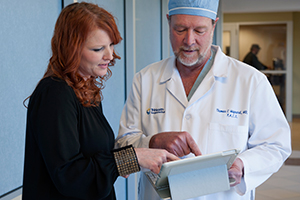Benefits of Robotic Assisted Surgery

Surgery often is the best method to treat many heart, urology and gynecology problems. Because of the techniques it affords physicians, robotic-assisted surgery often is the best form of surgery for these problems.
When compared to traditional surgical methods, robotic-assisted surgery results in patient benefits such as:
- Less pain
- Faster recovery
- Quicker return to normal daily activities
- Less scarring
- Less risk of infection
- Less blood loss
- Fewer transfusions
Risks
Like any major surgery, robotic-assisted surgery carries inherent risks. However, they are no more serious than traditional methods of surgery. The main “risk” associated with robotic-assisted surgery is the possible need to convert to open surgery.
Resuming Normal Activities
Every patient is different, and healing time depends on your particular circumstances. Most patients, however, are able to resume normal activities, including working, within several weeks.
Follow-Up Treatment
The follow-up treatment for robotic-assisted surgery is similar to that for traditional methods of surgery. However, because of robotic-assisted surgery’s inherent benefits (shorter recovery time, smaller incisions, etc.), treatment will progress on a more progressive schedule.
Additional Benefits
For cardiac and thoracic surgery patients
Traditional open surgery to treat disorders of the heart, lungs and esophagus requires making a large incision, splitting of the breastbone and spreading the ribs to access the thoracic space. In addition to leaving an 8- to 10-inch scar down the center of the chest, this increases infection risk and leads to a lengthy recovery time of eight to 12 weeks.
Robotic-assisted cardiac and thoracic procedures are performed through 1- to 2-centimeter incisions, without spreading or cutting the breastbone or ribs. This minimizes blood loss, pain and scarring; lessens the risk of infection; and promotes a faster recovery and a quicker return to normal activities.
For urologic surgery patients
Traditional open urologic surgery requires large incisions on the abdomen to access the pelvic organs. Common drawbacks of this procedure include significant post-surgical pain, a lengthy recovery and an unpredictable, potentially long-term impact on continence and sexual function.
Robotic technology enables potentially traumatic urologic procedures to be performed through 1- to 2-centimeter incisions. This minimizes blood loss, pain and scarring; promotes a faster recovery and a quicker return to normal activities; and significantly reduces the incidence of erectile dysfunction and urinary incontinence. In cases involving cancer removal, the enhanced visualization, dexterity, precision and control that robotic technology provides results in excellent cancer control.
For gynecologic surgery patients
Traditional open gynecologic surgery requires a large abdominal incision for access to the uterus and surrounding anatomy. It can come with significant pain, trauma, a long recovery process and threat to surrounding organs and nerves.
Robotic technology enables potentially traumatic hysterectomies and other gynecologic procedures to be performed through 1- to 2-centimeter incisions. This minimizes blood loss, pain and scarring, and promotes a faster recovery and a quicker return to normal activities. In cases involving cancer removal, the enhanced visualization, dexterity, precision and control that robotic technology provides results in excellent cancer control.